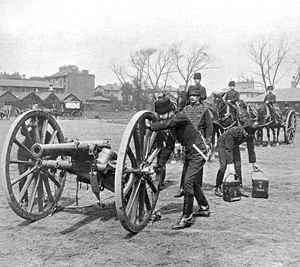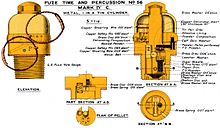- Ordnance BL 12 pounder 6 cwt
-
Ordnance BL 12 pounder 6 cwt 
On the parade ground circa. 1897Type Light field gun Place of origin  United Kingdom
United KingdomService history In service 1894 - 1916 Used by British Empire Wars Second Boer War
World War ISpecifications Weight Mk IV : 656 pounds (298 kg) (barrel & breech),
2,008 pounds (911 kg) (total)[1]Barrel length Mk I : Bore 59 inches (1,499 mm);[2]
Mk IV : Bore 66 inches (1,676 mm), total 71.05 inches (1,805 mm)[1]Shell Separate loading BL, 12.5 pounds (5.67 kg) Shrapnel Calibre 3-inch (76.2 mm) Elevation -8° - 16°[1] Traverse nil Rate of fire 7-8 rounds/minute[3] Muzzle velocity 1,585 feet per second (483 m/s)[1] Maximum range 3700 yds (No. 56 Fuze, Time setting)
5800 yds (No. 57 Fuze, Time setting)
5400 yds (No. 56 Fuze, Percussion setting)[4]The Ordnance BL 12 pounder 6 cwt was a lighter version of the British 12 pounder 7 cwt gun, used by the Royal Horse Artillery. The "6 cwt" referred to the weight of the gun and barrel to differentiate it from other 12 pounders guns. One hundredweight (cwt) is 112 pounds (51 kg), so the total weight was 672 pounds (305 kg).
Contents
History
Problems arose when the standard BL 12 pounder 7 cwt gun was used in the great Indian cavalry manoeuvres of 1891. The carriage was found to be too complicated, and dust caused the metal surfaces of the axle traversing device to seize.[5] It also proved too heavy for horse artillery, which was intended to support cavalry in battle, to manoeuvre.
The 12 pounder 6 cwt gun was therefore developed in 1892, when the new more powerful cordite replaced gunpowder, as a lighter version of the BL 12 pounder 7 cwt gun. It had a barrel 18 inches (460 mm) shorter, on a lighter and simpler carriage, and it entered service in 1894. In 1899 a primitive recoil-absorbing system was added. The weapon was made obsolete in British service by the acquisition of the modern quick-firing Ehrhardt QF 15 pounder in 1901, and was replaced by that and later by the QF 13 pounder from 1905.
The early No. 56 Fuze burned too fast, a maximum of only 13 seconds, and hence could only be time set for a maximum range of 3700 yards. The No. 57 "Blue" Fuze was introduced during the Boer war. It had a slower burning powder train and hence could be time set for ranges up to 5800 yards. A maximum range of 6000 yards was quoted in use in the First World War.[6]
Combat use
Second Boer War
The gun was used by the Royal Horse Artillery, and together with the BL 15 pounder, it provided the main British firepower. Eighteen guns were also used by the Royal Canadian Artillery in this war.[7] A total of 78 guns fired 36,161 shells.[8]
World War I
A battery of 6 guns served in the East African Campaign as the 8th Field Battery. It arrived with the Calcutta Artillery Volunteers in October 1914, and the guns were towed by teams of oxen.[9]
Notes
- ^ a b c d Hogg & Thurston 1972, page 52
- ^ Text Book of Gunnery 1902, Table XII, Page 336
- ^ Hall, June 1971
- ^ Hall, June 1971.
- ^ Hall, December 1972
- ^ Hogg & Thurston 1972
- ^ Canada & The South African War, 1899-1902. Units. Brigade Division, Royal Canadian Field Artillery
- ^ Appendices 28 and 29 of the Royal Commission on the War in South Africa
- ^ Farndale 1988, page 316
See also
- Field artillery
- List of field guns
- British standard ordnance weights and measurements
References
- Text Book of Gunnery, 1902. LONDON : PRINTED FOR HIS MAJESTY'S STATIONERY OFFICE, BY HARRISON AND SONS, ST. MARTIN'S LANE
- Dale Clarke, British Artillery 1914-1919. Field Army Artillery. Osprey Publishing, Oxford UK, 2004 ISBN 1 84176 688 7
- General Sir Martin Farndale, History of the Royal Regiment of Artillery: Forgotten Fronts and the Home Base 1914-18 ISBN 1 870114 05 1
- Major Darrell D. Hall, "Guns in South Africa 1899-1902" in The South African Military History Society. Military History Journal - Vol 2 No 1, June 1971
- Major Darrell D. Hall, "Field Artillery of the British Army 1860-1960. Part I, 1860 - 1900" in The South African Military History Society. Military History Journal - Vol 2 No 4, December 1972 (web page is incorrectly titled 1900-1914)
- I.V. Hogg & L.F. Thurston, British Artillery Weapons & Ammunition 1914-1918. London: Ian Allan, 1972
Surviving examples
One piece made in 1901 and marked "RCD 1907" on gun-metal sight mount, with King Edward VII cypher and crown inletted in top of barrel, parked in front of Stethem Hall, the HQ building of CFB Kingston.
External links
British Empire Small Arms & Ordnance of the Victorian era 
Side arms Muskets and Rifles Brown Bess musket · Baker rifle · Brunswick rifle · Pattern 1851 Minié rifle · Pattern 1853 Enfield rifle-musket · Snider-Enfield rifle · Martini-Henry rifle · Lee-Metford rifle · Magazine Lee-Enfield (MLE) rifleArtillery Field Artillery SBML 9 pounder 13 cwt · RBL 9 pounder · RBL 12 pounder · RBL 20 pounder · RML 9 pounder 8 cwt · RML 13 pounder 8 cwt · RML 16 pounder 12 cwt · BL 12 pounder 7 cwt · BL 12 pounder 6 cwt · QF 12 pounder 8 cwt · BL 15 pounder · QF 1 pounder pom-pomMountain artillery Howitzers, medium,
and heavy artillerySiege & garrison artillery SBBL 32 pounder · SBML 24 pounder · SBML 8 inch 65 cwt · RBL 40 pounder · RML 25 pounder 18 cwt · RML 40 pounder gun · RML 64 pounder 64 cwt gun · RML 64 pounder 58 cwt · RML 64 pounder 71 cwt gun · RML 80 pounder · RML 6.6. inch gun · RML 8 inch howitzer · BL 5 inch gun Mk I - V · BL 6 inch 30 cwt howitzerMortars 13 inch 36 cwt mortar · 10 inch 18 cwt mortar · 8 inch 9 cwt mortarWar rockets Congreve 6-pounder · Congreve 12-pounder · Congreve 24-pounder · Boxer · Hales 9-pounder · Hales 24-pounderMachine guns Categories:- Artillery of the United Kingdom
- Field guns
- World War I guns
- World War I artillery of the United Kingdom
- Second Boer War artillery
- 76 mm artillery
Wikimedia Foundation. 2010.

